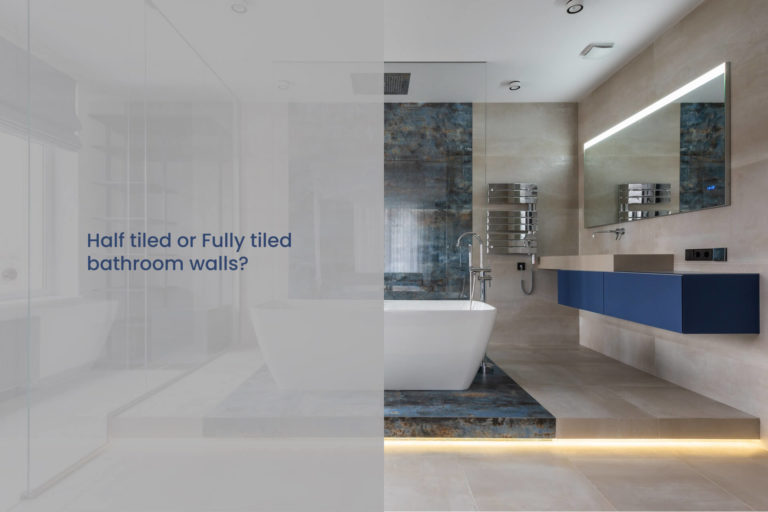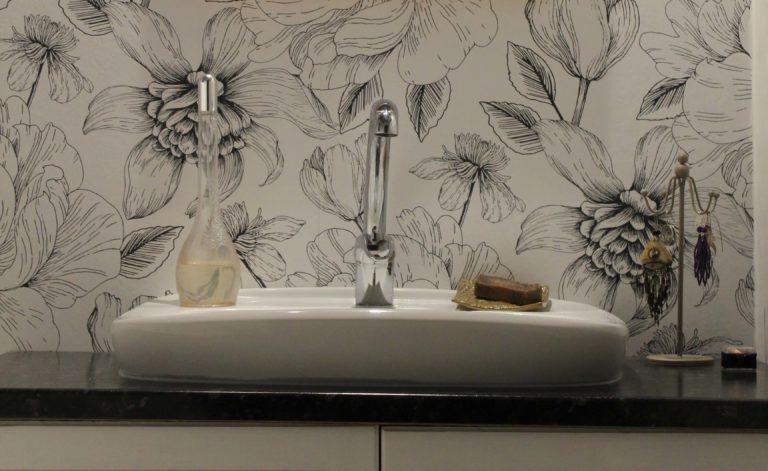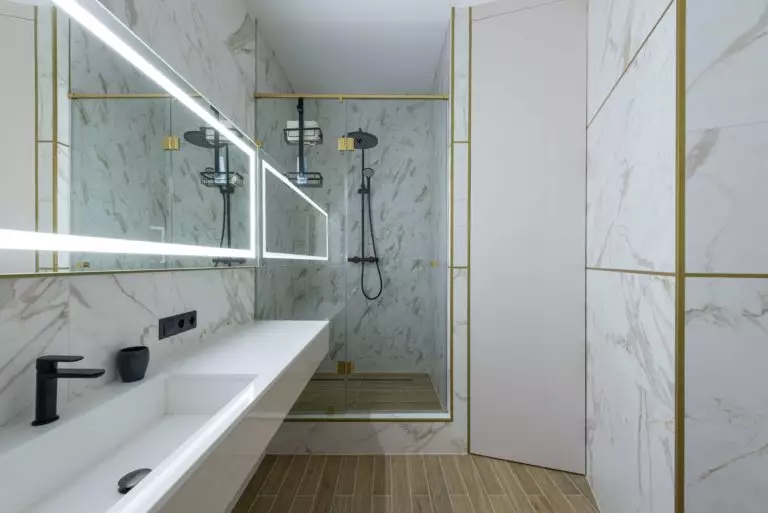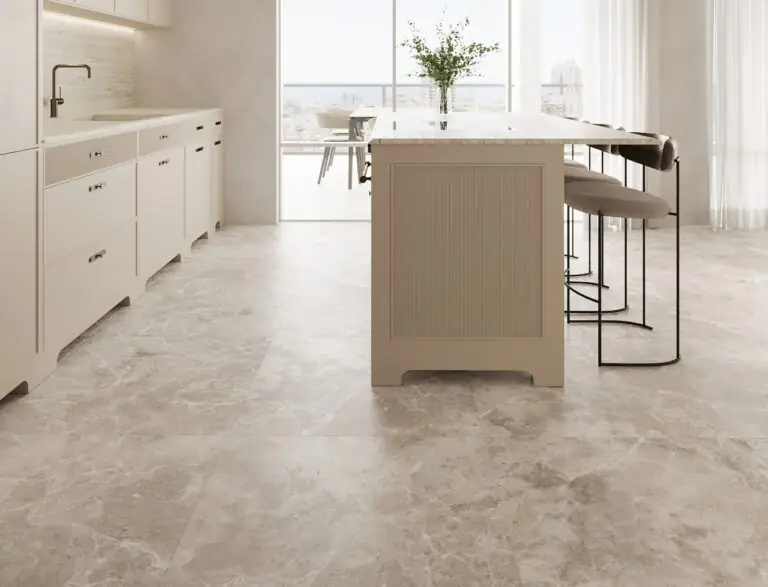Half tiled or fully tiled bathroom walls?: weighing the pros and cons
When it comes to finishing a bathroom, the first material that comes to mind is, of course, tiles, or at least porcelain stoneware. Indeed, tiles have repeatedly proved their advantage as a way of finishing this type of premise. It would seem, as is said in one very well-known quote, do not look for good from good – however, everything is not so simple again, as it often happens in design.
The fact is that today the full tiling of the bathroom is criticized more and more often, and the tendency to half tiled bathroom walls is taking shape more and more clearly. Both solutions have their pros and cons and, of course, opponents and supporters. Let’s take a closer look at the advantages and disadvantages of full and half tiled bathroom walls – perhaps this will help you make the right decision when the time comes.
Half tiled bathroom walls
There are several options for partial bathroom tiling. The most common is decorating wet areas with tiles, while other materials are used for the rest of the wall. Two more solutions are tiling certain zones around the perimeter (while the laying line changes height depending on the framing of this or that element, but there is also a minimum of 35 inches (90 cm)) or a clear lining of the bathroom around the perimeter. Whichever one you choose, the pros and cons of this type will be approximately the same.
Pros
There are many arguments in favor of a half tiled bathroom. Among them:
- Fewer tile costs. Obviously, you will need significantly fewer tiles if you do not decorate the entire wall area with tiles and porcelain stoneware. This is especially important when you want to use expensive and exclusive material.
- Variety of finishes. You can combine tiles with a wide variety of materials – from traditional to super hot. Below we will talk in more detail about materials that suggest stylish combinations with tiles.
- Easily place wall decor and accessories. Hanging mirrors, shelves, posters, or light fixtures on a tiled wall takes a lot of work. In the case when there are areas free from tiles, decorating is much easier.
- Easy to update. If you want to slightly change the color or texture of a fully tiled bathroom, this is equivalent to a full-scale remodel – just dismantling the material is complicated and messy and requires a lot of time. If you tile the walls only partially, you can limit yourself to replacing the decorative panels or painting in a different shade.
Cons
As you can see, the half-tiled bathroom has many advantages; however, there are also disadvantages in this design:
- Visual imbalance. It is not uncommon for a partially tiled bathroom to appear incomplete and unbalanced. This often happens in cases where the finish is not well thought out, and the materials that are cheap and incompatible with each other are used.
- The need for professional help. Not everyone can independently develop a harmonious tile layout and select suitable materials for it. That is why it is often necessary to order a project from a designer, which is an additional cost.
- The need for additional materials. To create a beautiful transition from tile to other finishes, you need skirting boards, moldings, and curbs, the final cost of which risks offsetting any potential savings.
- Risk of mold. As you know, ceramics are not very sensitive to fungus (unless, of course, grouting is taken into account). But you will have to be a little afraid of paint, panels, and wood since high humidity will affect them, even if they are not located in wet areas. That is why you will have to especially carefully consider the ventilation of the bathroom and additional protection against mold fungi.
What materials can be combined with bathroom tiles?
Obviously, if half of the bathroom is tiled, you have no way to leave the rest of the walls without covering them at all. We bring to your attention the most demanded and popular combinations for tiles.
- Wall painting. One of the most evident and successful solutions. You can use paint to match the tiles or choose a contrasting one and even try art painting on the wall. In this case, the most important thing is to use a paint that is suitable in composition, which will be much cheaper than tiles. However, you still have to be puzzled by purchasing moldings and baseboards, especially if you have chosen a classic interior.
- PVC panels. This combination is rarely used and only in cases where the budget needs to be reduced to the limit. It is challenging to find harmonious combinations in this case, and the fact is that PVC panels are inexpensive and look accordingly. This is why only use them when you have no choice.
- Shiplap. Today it is often combined with tiles to create an authentic interior in a trendy farmhouse or Scandinavian style. This solution looks very interesting. However, shiplap finishing is possible only away from wet areas. If you like this option, choose the most uncomplicated design tiles – in light and neutral or dark and deep colors and without any pretentious patterns.
- Wall texture. If you cannot allocate a significant amount for renovations, but you still want to create a spectacular interior in a bathroom with half-tiled walls, pay attention to wall texture. Today, it can imitate a wide variety of surfaces – from marble to brick – and this is the shortest path to harmony and an exclusive look for your bathroom.
- Decorative panels. Wood, brick, 3D, colored glass – modern panels offer many solutions, most of which match perfectly with tiles. Focus on the style of your bathroom: it will become a kind of common denominator, to which you have to lead both the tile design and the type of panel.
Fully tiled bathroom
The use of tiles on all vertical bathroom surfaces seems to us a more familiar solution. However, it’s still worth talking about its advantages and disadvantages – at least in comparison to half-tiled bathroom walls.
Pros
You probably know enough about the benefits of fully tiled bathroom walls. However, just in case, let’s recall the most obvious ones:
- An endless variety of options. Today, there are hundreds of manufacturers worldwide on the market of ceramic tiles and porcelain stoneware, and the number of collections is in the hundreds of thousands. In the catalogs of stores and online resources, you can see the wealthiest palette of shades, patterns, and imitations of various textures. In such a situation, it is ridiculous even to think that you will not find what is ideal for you among such a variety.
- No need to look for additional decor. To diversify the monotonous surface of painted walls, many resort to artistic murals, frescoes, and decorative stickers – and this is not cheap. In the case of tiles, decor, including large-scale panels, is usually included in the collection, and you just have to choose a place to install it.
- Practicality. The tile does not require any supernatural maintenance – it is enough to regularly wipe it down and wash it with ordinary cleaning agents to keep it in perfect condition.
- Durability. Tiles can last for years or even decades. It will not swell and peel off like paint, will not swell like wood and not be scratched like plaster, and can fall off only in cases where the installation is performed in violation of technology.
- Balanced costs. You buy only the tiles you need from the selected collection and do not waste time or money looking for materials to complement your finish.
Cons
And now – a few words about the reverse side of the medal, namely, about the shortcomings mentioned by some opponents of the whole decoration of the bathroom with tiles or porcelain stoneware:
- The need for careful preparation of the wall. For the tile cladding to be perfect, the walls must be leveled to the millimeter, which is an extra cost of time and building mixtures.
- Problems with decor placement. If you need to hang something on a tiled wall – it could be a mirror or a sconce – you will have to drill the tiles. And this must be done with a special drill and following a particular algorithm; otherwise, the tile may crack. Not everyone has such a tool and skills, so you will have to invite a specialist.
- The complexity of change. There is also a downside to tile durability: it can get boring. And if you decide to update the bathroom finish, you will have to carry out full-scale work with dismantling the tiles, re-leveling the walls, and applying a new covering. Many even thinking about it leads to a panic state.
So, which is better – a half-tiled bathroom or a fully tiled bathroom? Perhaps we will upset you, but there is no answer to this question since any bathroom design is a matter of the owners’ financial capabilities, needs, and tastes. Weigh the pros and cons of such options carefully – we sincerely hope that our advice will help you make the right decision.




